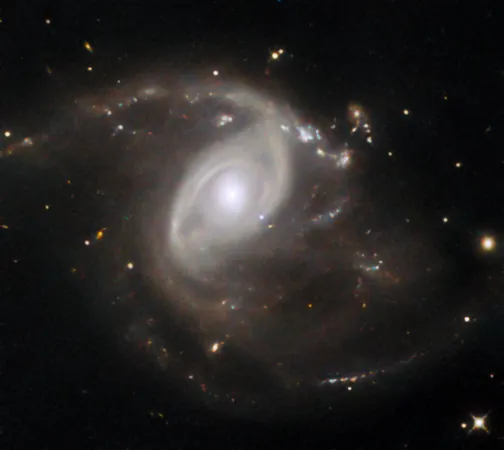
Discover the Spectacular Supernova SN 2024PI in the Distant Galaxy LEDA 22057!
2025-01-03
Author: Nur
A breathtaking image captured by the NASA/ESA Hubble Space Telescope showcases the galaxy LEDA 22057, located a staggering 650 million light-years away in the constellation Gemini. This galaxy is currently in the spotlight for hosting a supernova explosion that has astronomers buzzing with excitement. Known as SN 2024PI, this astronomical event was first detected by an automated survey in January 2024, which meticulously scans the northern night sky every two days, amassing data on over 10,000 supernovae.
In the stunning image, SN 2024PI can be found just down and to the right of the galaxy's bright nucleus, appearing as a faint pale blue dot against the backdrop of LEDA 22057's ethereal spiral arms. This particular snapshot was taken roughly six weeks after the discovery of the supernova, highlighting its gradual dimming from the blistering brilliance it displayed at its peak.
SN 2024PI is classified as a Type Ia supernova, a category that requires a unique stellar object known as a white dwarf—essentially the stellar remnant of a star whose mass is less than eight times that of the Sun. Once these stars deplete their hydrogen supply, they expand into red giants, eventually shedding their outer layers and leaving behind a dense white dwarf, sometimes accompanied by a beautiful planetary nebula. White dwarfs are incredibly hot, with surface temperatures exceeding 100,000 degrees Fahrenheit, and are dense enough to pack the mass of our Sun into a volume no larger than Earth.
Interestingly, while nearly all stars in the Milky Way are on a path to become white dwarfs—our Sun is expected to follow this fate in approximately five billion years—not all of these remnants will undergo explosive endings as Type Ia supernovae. For a white dwarf to detonate in such a spectacular fashion, it must be part of a binary star system. Here’s where things get thrilling: when a white dwarf siphons material from its companion star, it can accumulate mass beyond a critical limit. This leads to an uncontrollable catastrophic reaction of nuclear fusion, resulting in a titanic explosion that can illuminate the night sky across galaxies.
So, could SN 2024PI be a glimpse of the cosmic fate waiting for our own star system? As astronomers continue to study these celestial events, each supernova not only expands our understanding of stellar evolution but also offers a window into the distant past and the future of our universe. Stay tuned as we unravel the mysteries of the cosmos, one supernova at a time!
 Brasil (PT)
Brasil (PT)
 Canada (EN)
Canada (EN)
 Chile (ES)
Chile (ES)
 Česko (CS)
Česko (CS)
 대한민국 (KO)
대한민국 (KO)
 España (ES)
España (ES)
 France (FR)
France (FR)
 Hong Kong (EN)
Hong Kong (EN)
 Italia (IT)
Italia (IT)
 日本 (JA)
日本 (JA)
 Magyarország (HU)
Magyarország (HU)
 Norge (NO)
Norge (NO)
 Polska (PL)
Polska (PL)
 Schweiz (DE)
Schweiz (DE)
 Singapore (EN)
Singapore (EN)
 Sverige (SV)
Sverige (SV)
 Suomi (FI)
Suomi (FI)
 Türkiye (TR)
Türkiye (TR)
 الإمارات العربية المتحدة (AR)
الإمارات العربية المتحدة (AR)